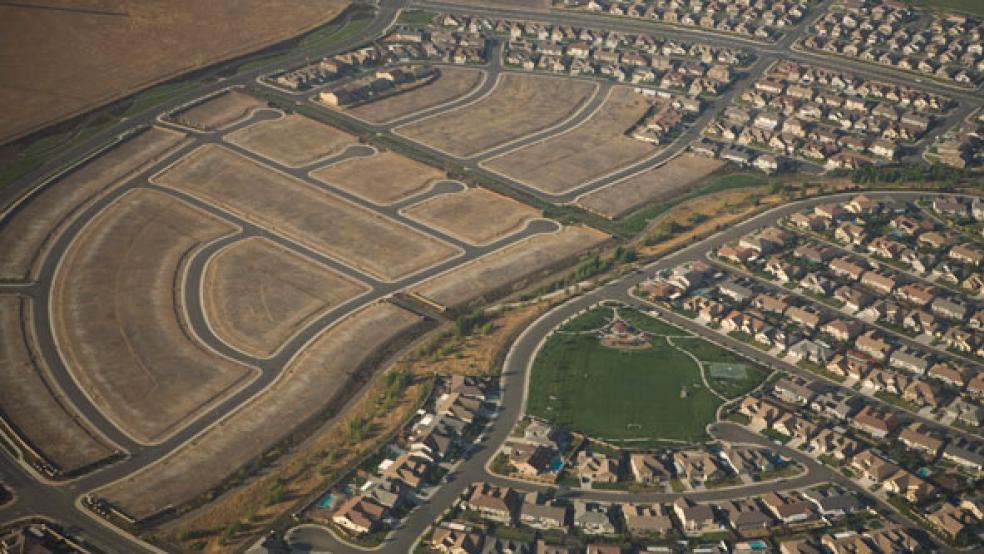If there’s a defining image of the housing crunch, it might be the demolition of four brand-new luxury homes in Victorville, Calif. The developer built them in September 2007 as part of a planned 16-unit project, but abandoned the effort after home prices in the area fell more than 50 percent in 18 months.
After foreclosing, the Texas-based bank, which held the loan, decided it was cheaper to tear them down than to cut prices and sell. So it hired a wrecking crew that flattened the homes and sold off the gorgeous granite countertops, whirlpool baths and double-pane windows to passers-by.That story represents what’s happening to Victorville itself, a fringe suburb of 116,000 in the high desert 100 miles north of Los Angeles as it slides toward higher unemployment, rising crime and increased poverty.

Warren Karlenzig, who runs an urban planning consulting firm, has been watching Victorville as part of his research on the future of suburbs nationally, and has little hope for the area’s recovery. It’s a two-hour drive from most jobs, has little public transportation, claims no downtown to speak of, and has few sidewalks – a package that’s unlikely to attract buyers. Nationally, some experts say that the housing collapse may have tipped far-flung suburbs like Victorville into permanent stagnation. Brookings Institution demographer William Frey cites new census data showing that all of the 100 fastest-growing exurbs and outer suburbs experienced lower growth from 2008 to 2011 compared with 2003 to 2007.
"The heyday of exurbs may well be behind us,” Yale University economist Robert J. Shiller, co-creator of the Case-Shiller Home Price Indices, said in April. In 2011, the populations of extreme suburbs like Victorville grew just .4 percent on average, down from more than 2 percent in 2006.
RELATED: America's Best Kept Secret: Rising Suburban Poverty
Like tree rings, the layers of suburbs around a city say something about its age. Many of the inner suburbs were built before World War II, according to housing expert John McIlwain of the Urban Land Institute A second ring was started in the ‘50s and saw high growth rates in the ‘60s and ‘70s. The ‘90s and early 2000s saw a new frontier, the outer exurban ring, whose growth was fueled by lower land costs, cheap gas and often-risky loans.
"These are places with mini-McMansions and large lots; it’s where David Brooks’ ‘patio man’ moved out to,” says McIlwain, referring to The New York Times columnist’s archetypal refugee from the inner suburbs who bought a bigger, more affordable house with all the amenities on the fringe.
Over time, the older first- and second-ring suburbs often became more like the cities they border, more “That Girl” than “Leave It to Beaver.” They’re denser, with more high-rise apartments than before. They offer better public transportation. And they have more people working in jobs closer to home. In Victorville, 75 percent of people spend more than 2 hours total getting to and from their jobs daily, and more than half must leave the house before 5 a.m., according to 2010 census figures.
Though the housing crash began the decline in the exurbs’ fortunes, the increase in energy prices starting in late 2007 may have been the trigger. In Victorville, Karlenzig notes that the spike in oil prices didn’t just affect commuting costs, it also sent residents’ air conditioning bills sky-high in a desert community where summer temperatures average near 100 degrees. In turn, when housing cratered, so did a key source of jobs since many of Victorville’s residents, many of them Hispanic immigrants who worked in the construction trades.
Also driving down demand for houses in the outer suburbs are demographic trends. Recent college graduates and young professionals are making the place they live a priority – 77 percent of them say they plan to live in an urban core even if it’s more expensive, according to a February 2010 study by real estate consultancy RCLCO. The study’s author found that more Gen-Y’ers than Gen-X’ers are willing to live in a smaller space if it means they can walk to work or shops. At the other end of the age spectrum, baby boomers are now selling their houses as they retire and are looking to live nearer urban amenities.
RELATED: 12 Markets Where It's Better to Rent
Another kind of demographic shift is happening as well. The average household size continues to drop, with a lower proportion of households raising children now than in the past and the percentage of single people at an all-time high. That’s important, since smaller households prefer to live in walkable, higher density places, according to the RCLCO study.
Today, Victorville’s unemployment and poverty rates stand at 14 and 21 percent, respectively, both 6 points higher than the national figures. Housing demand there has shrunk as new buyers have disappeared – prices have plummeted from an average of about $300,000 in 2007 to $109,000 today.And new home permits went from almost 8000 from 2004−2006 to about 750 in 2008−2010, according to a 2010 report by Karlenzig.
Similar stories are playing out in fringe suburbs elsewhere. In Georgia’s Barrow County, 50 miles northwest of Atlanta, tax revenues declined more than 18 percent between 2008 and 2011, and county officials expect a 16 percent drop in the coming year alone. That’s led school officials there to propose cutting the school year by 20 days next year.
In neighboring Jackson County, the number of building permits issued went from 684 in 2006 to just 34 in 2010 and the largest city of Braselton is almost out of money, a quarter of its tax revenues eaten up by debt financing. Part of the area’s problem, according to University of Georgia economist Jeffrey Dorfman, is that Atlanta commuters now can afford to buy closer to the city, so they’re moving.
In the Chicago area, handfuls of houses in some subdivisions of Yorkville, 50 miles southwest of Chicago, sit alone among acres of lots that were cleared for new homes a few years ago at least 10 of Yorkville’s subdivisions are unfinished. Prior to the crash, 3 to 5 percent of the town’s students qualified for subsidized lunches; now that figure is in the double digits, according to the town’s school superintendent. Thirty-five miles north, in the exurb of Hampshire, a brand-new high school built to handle an expected influx of students during the boom years now has 15 shuttered classrooms, and the town is struggling to pay off the resulting debt.
Nationally, the unemployment rate in exurbs rose by 126 percent during the recession, versus 113 percent in urban areas. House prices in the suburban fringes have not come back like those in the city cores, according to a recent Wall Street Journal-Zillow analysis. And while no one has tracked poverty rates in the exurbs themselves, poverty is rising faster in the suburbs as a whole than in cities: The number of suburban households in poverty grew 53 percent between 2000 and 2010, compared with 23 percent in urban areas, according to Brookings.
No one seems willing to bet that exurbs will grow anytime soon. In its 2012 report on real estate trends, the Urban Land Institute notes that real estate investors have no interest in suburban office parks and commercial real estate in farther-out suburbs because they see little chance of economic recovery or higher rents there.
But even as life on the edges gets harder, people who might like to leave for houses closer in are stuck because they can’t sell their homes, says Frey, who recently analyzed new mobility data from the Census Bureau. The twenty- and early thirty-somethings are putting off getting married, having children, and buying homes because they’re not getting well-paying jobs and can’t get mortgages because of tight credit standards, he says. Worse, for the first time since at least the 1930s, a succeeding generation of buyers – Gen X – is smaller than the one that went before it – baby boomers, according to McIlwain. “Even if there were no housing recession, you would still have a drop in demand from those move-up [buyers],” he says.
As long as middle-class incomes stay stagnant, there’s no clear road back to prosperity for exurbs like Victorville, he says. So for now, exurbia may be the new inner city, a place where people who are struggling economically congregate until they can put together enough money to leave for decent paying jobs elsewhere.
"There are a lot of people who say that we’re going to see more of the new ghettos out there [in the exurbs] than anywhere else,” says McIlwain. “I can see the logic of that.”





